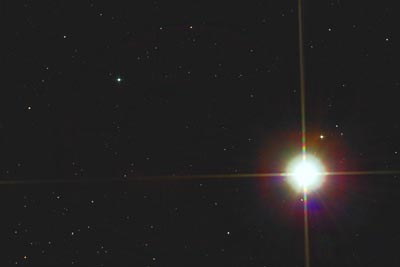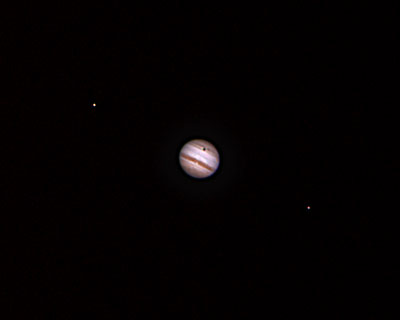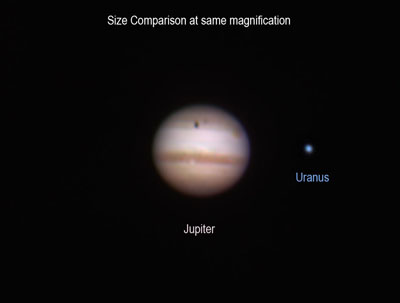Jupiter and Uranus in
Conjunction AND Opposition AND .8 degrees apart
Planetary Grouping at Sundown 9/17/10
Uploaded
9/19/10

| This
stunning pairing all in one night! And while our seeing here
in Payson is never good, the wide field of the pair marks the
first time I had ever recorded both objects in one frame. Visually,
Jupiter had a single belt and the great red spot was just coming
onto the disk. Also, a jet black moon shadow is on this planet.
Uranus is very dim photographically. So dim, I had to use long
1/10 second exposures just to see it at all on the CCD. It is
very tiny, about twice the size in angular extent of Jupiters
moon Ganymede. A tough target indeed! |
 Here we can see brilliant Jupiter on the lower right and
the bright "star" on the upper left is Uranus. Look
carefully at the diffraction spikes and they are green.
Here we can see brilliant Jupiter on the lower right and
the bright "star" on the upper left is Uranus. Look
carefully at the diffraction spikes and they are green.
|
Select an image size for
a larger view:
800 x 600
1024 x 768
1600 x 1200
|
 Prime focus shot with the 8" f/4. To the left is Io,
right is Europa, and Ganymede is transiting the disk.
You can see on the upper disk, the belt is still
missing.
Prime focus shot with the 8" f/4. To the left is Io,
right is Europa, and Ganymede is transiting the disk.
You can see on the upper disk, the belt is still
missing.
|
Select an image size for
a larger view:
1024 x 768
|
 With the 5x barlow things are a bit unsteady, but here you
can see Ganymede just to the left of its shadow on the upper
disk. I also shot Uranus at the same magnification and placed
it next to Jupiter here for Illustration purposes to show
the size and color difference. Note that Uranus is about
twice the size of Ganymede. I recorded with the DMK CCD
and a set of SBIG interference color filters for the RGB data.
With the 5x barlow things are a bit unsteady, but here you
can see Ganymede just to the left of its shadow on the upper
disk. I also shot Uranus at the same magnification and placed
it next to Jupiter here for Illustration purposes to show
the size and color difference. Note that Uranus is about
twice the size of Ganymede. I recorded with the DMK CCD
and a set of SBIG interference color filters for the RGB data.
|
Select an image size for
a larger view:
1024 x 768
|
Optics: 8" f/4 Newtonian Astrograph w/Baader MPCC Coma Corrector
OR with Televue 5x Powermate Barlow
Platform: Astrophysics AP1200
Camera: DMK CCD at 1024 x 768
Exposure: 1/10 - 1/64
Location: Payson, Arizona
Elevation: 5150 ft.
Sky: Seeing 5/10, Transparency 9/10
Outside Temperature: 60F
Processing Tools: Photoshop CS2, Images Plus 3.82
HOME GALAXIES EMISSION NEBS REFLECTION NEBS COMETS
GLOBULARS OPEN CLUST PLANETARIES LINKS

|